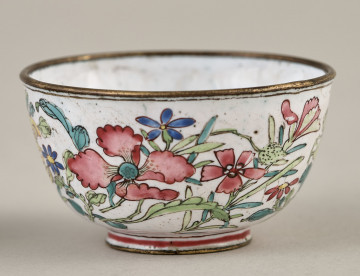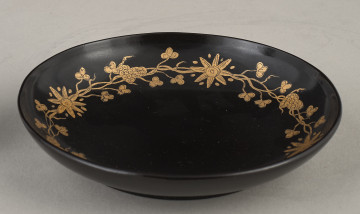
Saucer
18th-19th century
Castle Museum in Łańcut
Part of the collection: Orient
Copper saucer on three short feet in the shape of a halved peach fruits with a twig handle. It was covered with fa-lang, enamel type, green on the outside gradually changing to pink. Pink on the inside. The mirror is decorated with a three bats motif and stylized clouds in deep pink. The bowl is dated to 18th/19th century. According to Chinese symbolism, the bat is a symbol of luck and longevity. Bat in Chinese is a homonym of the word "fu" - happiness. Following the division of the animate and inanimate world, where male and female elements, good and evil, passive and active forces are intertwined, bats were associated with the male element, even with the masculinity itself. For that reason these creatures were often depicted in the midst of flowers and fruits associated with the feminine element, with the world of women. Bats were often depicted with a peach, a symbol of fertility. During the reign of Manchus, bats were a popular ornamental motif in China. People decorated vases and tea bowls with them, embroidered them on emperors' robes and carved them on furniture and imperial thrones.
Author / creator
Object type
Orient
Technique
enamelling
Material
copper
Creation time / dating
Creation / finding place
Owner
Castle Museum in Łańcut
Identification number
Location / status

18th-19th century
Castle Museum in Łańcut

2nd half of the 19th century
Castle Museum in Łańcut

17th-18th (?) century
Castle Museum in Łańcut
DISCOVER this TOPIC
Castle Museum in Łańcut
DISCOVER this PATH
Educational path